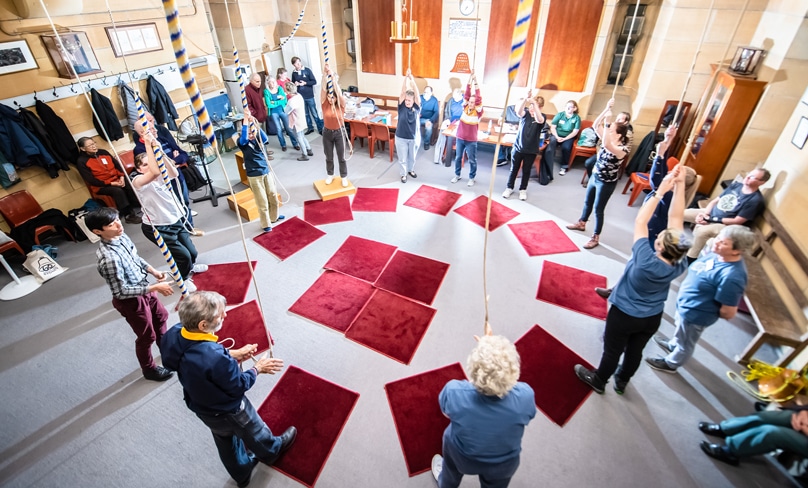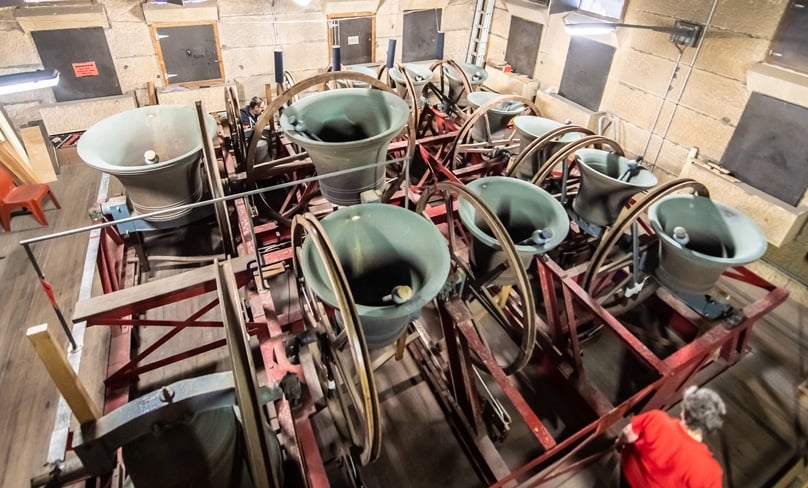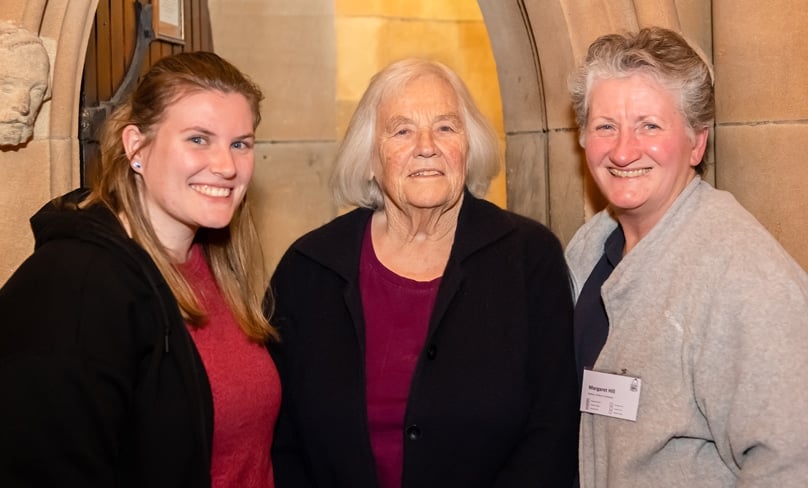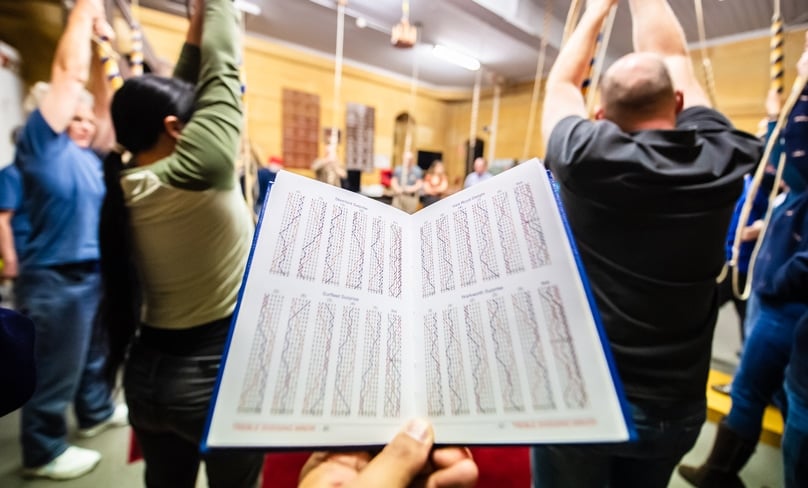
It’s not just for medievals: bell-ringing attracts a lively, unique and very modern sort of person. And – perhaps not a huge surprise – it can lead to marriage
Enid Roberts knows the “appeal” of ringing bells better than just about anybody.
After 75 years, she still slowly climbs the 126 spiral stairs to the belfry of St Mary’s Cathedral, and admits that while it takes a few days to get over, it’s well worth it.
As one of the world’s oldest bellringers, the 90-year-old said her passion for ringing is as strong today as it was when she first started back in 1947.
“It’s been marvellous, and after all these years I am still learning,” she smiled.
“And it really is so good for you. If you are ringing you don’t need a gym membership that’s for sure, as it’s not just pulling the ropes, it’s getting up and down all the stairs of the towers.
“I first started ringing when I was 15 after reading an advertisement in my local paper in Swinburne in England and I’m still going which says something.”
“Although I’d say it’s probably as good for you physically as it is mentally, as there is so much concentration and timing involved.
“I first started ringing when I was 15 after reading an advertisement in my local paper in Swinburne in England and I’m still going which says something.
“I was the first female bellringer then and also the first female at St Mary’s Cathedral.
“I have travelled around the world, and no matter where I am, I always look up the local bellringers and know I will be welcomed with open arms.
“It has given me opportunities I would never have dreamed of, I have met so many people connected with bellringing who I now consider lifelong friends.”

Enid is one of a dedicated team of quiet achievers in a noisy job, ringing the bells which are not just an integral part of the cathedral experience but a familiar and historical part of the fabric and soundscape of the city of Sydney.
Formed in 1844, they are the oldest group of campanologists – those who study and practice bellringing – in Australia and today boasts an eclectic range of ringers including doctors, engineers, teachers, librarians, electricians, accountants and a parish priest.
And while the bells have changed over the years, one thing that hasn’t is how they are rung.
Despite common belief, the bells are not automated but rung by hand. The daily midday bell for the Angelus prayer and devotion is the only time they are mechanical.
Marking significant events in people’s lives, the bells can be heard at weddings, funerals, baptisms, civic events, Papal visits, jubilees and everything in between.
“St Mary’s Bell Tower captain Margaret Hill said that while bellringing was relatively new in Australia, it was becoming more and more popular among Catholics.”
Open to anyone, bellringing doesn’t require great physical strength, nor do you need any knowledge of music or mathematics. It’s all about rhythm, memory and concentration.
However, as the heaviest bell weighs 1741 kilos – the weight of a small car – the bell ringers often warn new comers not to mess with it as “it will always win”.
St Mary’s Bell Tower captain Margaret Hill said that while bellringing was relatively new in Australia, it was becoming more and more popular among Catholics.
“Bellringing is a very Anglican thing, a lot of Catholics have rung in Anglican churches for a long time, but more recently Catholics have wanted to ring in Catholic churches and many new peals that are going in churches in Australia are in Catholic ones,” she said.
“Catholics are getting a real taste for it and they like it.

“For me I came across it by accident, I booked a tour of the Cathedral on Australia Day in 2011 and as part of that was introduced to the bells and just loved them.
“I like going to Mass and bellringing is just another dimension to my faith.
“It’s doing something beautiful in a beautiful building with people who are now beautiful friends, I’m just sorry I didn’t find out about it 20 years earlier. Apart from the many misconceptions and jokes about hunchbacks and hanging onto ropes and being lifted high off the ground, we are very normal and safety conscious.
“Anybody can become a bellringer, all you really need is the interest, the time and the patience.
“If you are able to get up the stairs you can do it, sometimes they can take more effort than the ringing.”
“One of the very special things about our cathedral bells is that they are rung by real people, not by machines.”
Dean of the Cathedral Fr Don Richardson said the most important aspect of the cathedral bells is the call to praise God, but they are also a very valuable expression of human culture, and of a civilisation built on Christian foundations.
“When the bells are ringing, you always see people in Hyde Park and College Street looking up at the cathedral, listening to the pealing and if they make people curious or lift their thoughts above the mundane, then the bells are doing their job,” he said.
“Our bells are expressive of many moods, from the joyful peals of weddings, to the somber dignity of the half-muffled mourning ring, the distinctive triple sounding at the Consecration announcing to even passers-by that Christ is present, to the heroically long peals commemorating great events of Church or State.
“One of the very special things about our cathedral bells is that they are rung by real people, not by machines.
“Only the Angelus bells is automated.

“I know that change-ringing requires real skill, combining physical action with mental agility, teamwork, attentiveness and courage.
“And it is not the happy but raucous random clanging that one often hears from Mediterranean and European church towers, but the beautiful, precisely ordered and interlaced patterns of English-style change-ringing that calls Sydneysiders to worship in the Mother Church each Sunday morning.”
Many people find ringing quite addictive and it is common to find older ringers who started ringing when they were in their teens and have never grown tired of it.
Apart from physical and mental wellbeing, the obvious advantage to bellringing is having an instant community anywhere around the world.
Australia has more than 60 bell towers, with around one added per year since 1990, now boasting the second highest number of towers in the world behind England.
“I’m really into history and bell ringing seemed to be the historical form of music.”
It’s estimated there are currently a few hundred bellringers in Sydney, many of whom learn young, drop out during the busy years of marriage and children, and then come back to it later in life.
One of the younger ones is admin assistant Anna Perrin, who at 26, thanks bellringing for not only curing her fear of heights but for introducing her to husband Thomas.
“I’d just finished my HSC and was looking for something to do in my spare time similar to percussion which I studied at school and bellringing was just what I was looking for,” she said.
“I’m really into history and bell ringing seemed to be the historical form of music.
“I just loved it. Something just drew me in and the more I learnt the more I wanted to know.

“On my first day in 2016, the tower captain showed me around, and two months ago we married.
“I have a lot to thank bellringer for, that’s for sure.”
Parish priest of Holy Family at Lindfield / Killara, Fr Colin Blayney, has been ringing bells for more than 40 years and said they are quite simply a joyful call to prayer.
Having a belltower in his Church has meant he has been able to ring not only at St Mary’s but also in his own parish.
“I started many, many years ago while I was at university before I entered St Patrick’s Seminary at Manly, and sadly gave it away to concentrate on my studies,” he said.
“Bells remind you that religion can have beauty, and the bells are beautiful and add to that part of your faith.”
“It was something that I always loved doing and wasn’t re-introduced to until a few years ago, when a friend who was ringing at the cathedral asked me to join them.
“Pretty quickly I remembered the joy bellringing brought me and I have been doing it ever since.
“Bells remind you that religion can have beauty, and the bells are beautiful and add to that part of your faith.
“I would say to anybody looking for an interesting hobby to give it a go, there are so many positives and the people you meet and team spirit you develop are tremendous.”
